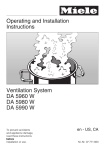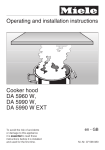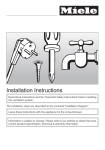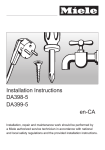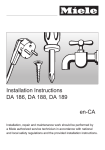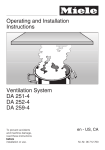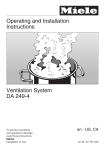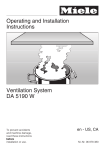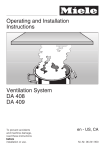Download Miele DA 5960 W Technical data
Transcript
Installation Instructions DA5960 W en-CA Read these instructions and the "Important Safety Instructions" before installing this hood. Installation, repair and maintenance work should be performed by a Miele authorized service technician in accordance with national and local safety regulations and the provided installation instructions. Caring for the environment Disposal of packing material Disposal of an old appliance The cardboard box and packing materials protect the appliance during shipping. They have been designed to be biodegradable and recyclable. Please recycle. Old appliances may contain materials that can be recycled. Please contact your local recycling center about the possibility of recycling these materials. ,DANGER Ensure that any plastic wrappings, bags, etc., are disposed of safely and kept out of the reach of babies and young children. Danger of suffocation! Before discarding an old appliance, disconnect it from the electrical supply and cut off the power cord to prevent it from becoming a hazard. 21 Appliance dimensions 22 Appliance dimensions dai2479 1) Air extraction mode 2) Recirculation mode 3) Recirculation vent installed upwards 4) and 5) Installation area Wall/ceiling area respectively for vent hole and outlet installation. For recirculation mode only 4) and only outlet installation. Ductwork ø 6" (150 mm), with reducing colla r ø 4 15/16" (125 mm) 6) If you plan to have a tiled backsplash or wall panel underneath the exhaust hood, this may cause difficulties when changing the filter, depending on the thickness and height of the tiles or panel. If this is the case the filter needs to be turned 180° and inserted the other way round. Les appareils de Miele peuvent être encastrés à ras ou avec débordement. Discutez de vos conditions d'installation avec votre architecte, décorateur de l'intérieure et installateur. 23 Appliance dimensions Distance between cooktop and hood (S) Do not install this exhaust hood over cooktops burning solid fuel. Provided a larger distance is not given by the manufacturer of the cooktop, follow the minimum safety distances between a cooktop and the bottom of the hood: Miele cooktops: - 24" (610 mm) above electric surfaces, - 26" (660 mm) above electric grill/boiler/fryers, - 24" (610 mm) above gas surfaces ß 25,000 BTU's (7.5 kW) and no burner greater than 10,250 BTU's (3 kW) , - 30" (762 mm) above gas surfaces > 25,000 BTU's (7.5 kW), - 30" (762 mm) above burner heads > 10,250 BTU's (3 kW). For example, a Wok used separately or in combination with a cooktop. Non-Miele cooktops: - 24" (610 mm) above all electric surfaces, - 30" (762 mm) above all gas surfaces, - 26" (660 mm) above electric grill/boiler/fryers. If several gas surfaces are installed under the hood, the total output must be considered when determining the minimum safety distance. 24 Be sure to follow the minimum safety distances given by the gas cooktop manufacturer to easily flammable materials e.g. upper cabinets. If local building codes require a greater safety distance, follow their requirement. If there is more than one appliance beneath the hood and they have different minimum safety distances always select the greater distance. See "Important Safety Instructions" for further information. The installation procedure differs depending on the model and venting method. Before beginning the installation: ^ Read all instructions. ^ Determine height (S), regarding the user’s body height, i.e. a comfortable height for the user. However, the greater the distance the less effectively cooking odors are drawn in. ^ If the hood is fitted flush to the ceiling, regard the possible unit height when selecting the installation height. Appliance dimensions Use the following distances when preparing a rear wall (screw ø 5 mm). *The middle retaining plate can vary in position, depending on the ventilation gap and the position of the outlet. It should be mounted as low as possible. If the exhaust hood is being mounted directly on the wall, follow the enclosed assembly. 25 Installation accessories dai2417 26 Installation accessories a 3 protective shields to prevent scratches to the chimney during installation. b 2 hose clips for securing the ducting. 8 large headed screws 5 x 40 mm for securing the retaining plates and the canopy c 1 reducing collar for use with 5" (125 mm) exhaust ducting. (S8 wall anchors included in the packaging are not for use in USA) d 2 protective strips for chimney mounting e Upper retaining plate secures the chimney extension 2 M 6 locking nuts for securing the unit f Middle retaining plate for additional stability of the chimney g Lower retaining plate secures the canopy and motor assembly. h Installation kit for recirculation mode; contains diverter and hose (optional accessory) 1 allen wrench for adjusting the unit height ,CAUTION 1 lever for dismantling the chimney To avoid risk of hand or other injury, avoid contact with sharp edges during the assembly and installation process. Installation instruction diagram 27 Plywood backing The majority of the weight of the installed ventilation system will be supported by the lower retaining plate. It must be firmly attached to the stud framing behind the drywall. If studs are not available in the required locations, a plywood backing (min. ½" (13 mm) thick) spanning at least two studs must be installed. Failure to adequately support the weight as stated may result in the ventilation system falling off the wall, causing personal injury and property damage. (If plywood backing is not needed, proceed to the included "Installation diagram".) To install a plywood backing ^ Determine and mark the location of the retaining plate for the canopy as outlined on the "Installation diagram". ^ Make a cutting line 3" (76 mm) above and 3" (76 mm) below the outline of the retaining plate. 28 ^ Find the studs to the left and right of the mounting location by tapping the wall or using a stud finder. ^ Mark a vertical cutting line along the center of each stud. ,CAUTION When cutting or drilling into the wall or ceiling, do not damage electrical wiring and other hidden utilities. ^ Remove the drywall between the cutting lines and replace it with plywood of a matching thickness (min. ½" (13 mm) thick). Tape the joints and refinish the wall. ^ Proceed to the enclosed "Installation diagram" to complete the installation. Installation Installation instructions Dismantling ^ See the enclosed installation instruction diagram. If the hood needs to be disassembled, follow the instructions on the installation diagram in the reverse order. ^ Please read the "Important Safety Instructions" and Installation instructions before installing this hood. A lever is enclosed for easier removal of the chimney extension. Protective film The casing is covered with a protective film to prevent scratching during transport. ^ Peel off the film before installing the casing parts. ^ After loosening both of the clamping screws on the chimney, slide the lever between the chimney and the chimney extension and gently apply pressure to ease the chimney from its hooks. 29 Air extraction ,WARNING Danger of toxic fumes. Gas cooking appliances release carbon monoxide that can be harmful or fatal if inhaled. To reduce the risk of fire and to properly exhaust air, the exhaust gases extracted by the hood should be vented outside of the building only. Do not vent exhaust air into spaces within walls or ceilings or in attics, crawl spaces or garages. To reduce the risk of fire, only use metal ductwork. Please read and follow the "IMPORTANT SAFETY INSTRUCTIONS" to reduce the risk of personal injury. Follow all local building codes when installing the hood. 30 Exhaust ducting and connections – The ducting should be as short and straight as possible, and the number of sharp bends should be minimized. – For most efficient air extraction, the diameter of the ductwork should not be less than 6" (150 mm). Use of flat ducts also reduces the air extraction efficiency. – Noise levels of the hood will increase if flat ducts or round ducts of less than 6" (150 mm) in diameter are used. – Use smooth or flexible pipes made from approved non-flammable materials for exhaust ducting. – Where the ductwork is horizontal, it must slope away from the hood at least 1/8" per foot (1 cm per meter) to prevent condensation dripping into the appliance. – If the exhaust is ducted through an outside wall, a Telescopic Wall Vent can be used. Air extraction Condensate trap optional accessory In some cases, a condensate trap may also be required to collect and evaporate any condensate which may occur. This optional accessory is available for ducts 5" (125 mm) and 6" (150 mm) in diameter. – If the exhaust is ducted into an inactive flue, the air must be expelled parallel to the flow direction of the flue. Never connect an exhaust hood to an active chimney, dryer vent, flue, or room venting ductwork. Seek professional advice before connecting an exhaust hood vent to an existing, inactive chimney or vent flue. ^ When installing a condensate trap, ensure that it is positioned vertically and if possible directly above the exhaust outlet. Important If the ductwork runs through rooms, ceilings, garages, etc. where temperature variations exist, it may need to be insulated to reduce condensation. 31 Electrical connection ,WARNING TO REDUCE THE RISK OF FIRE, ELECTRIC SHOCK, OR INJURY TO PERSONS, OBSERVE THE FOLLOWING: All electrical work should be performed by a qualified electrician in strict accordance with national regulations (for USA: ANSI-NFPA 70) and local safety regulations. Installation, repairs and other work by unqualified persons could be dangerous. Ensure that power to the appliance is OFF while installation or repair work is performed. ^ Verify that the voltage, load and circuit rating information found on the data plate (located behind the grease filter), match the household electrical supply before installing the hood. ^ Use only with ventilation hood cord-connection kits that have been investigated and found acceptable for use with this model hood. If there is any question concerning the electrical connection of this appliance to your power supply, please consult a licensed electrician or contact Miele’s Technical Service Department. ,WARNING: THIS APPLIANCE MUST BE GROUNDED 32 Grounding Instructions (USA and Mexico only) This appliance must be grounded. In the event of an electrical short circuit, grounding reduces the risk of electric shock by providing a path of least resistance. This appliance is equipped with a cord having a grounding wire with a grounding plug. The plug must be plugged into an outlet that is properly installed and grounded. WARNING - Improper grounding can result in a risk of electric shock. If there is any doubt, have the electrical system of the house checked by a qualified electrician. Do not use an extension cord. If the power supply cord is too short, have a qualified electrician install an outlet near the appliance. Important (USA and Mexico only) The hood comes equipped with a 4 ft (1.2 m) power cord with a NEMA 5-15 molded plug for connection to a 120 VAC, 60 Hz, 15 A power outlet. Important (Canada only) To increase security before the machine is installed, it is recommended to install a protective switch (30 mA). Important (Canada only) The hood must be hard wired accordingly: Black/Red wire: connect to L1 (live) White wire: connect to N (neutral) Green wire: connect to GND (ground) Technical data Maximum load . . . . . . . . . . . . . . 400 W Fan . . . . . . . . . . . . . . . . . . . . . . 350 W Overhead lighting . . . . . . . . . 1 x 50 W Voltage . . . . . . . . . . . . . . . . . . . . . 120 V Frequency . . . . . . . . . . . . . . . . . . 60 Hz Circuit rating. . . . . . . . . . . . . . . . . . 15 A Weight: DA 5960 W . . . . . . . . 49.6 lbs (22.5 kg) DA 5980 W . . . . . . . . . . 55.1 lbs (25 kg) DA 5990 W . . . . . . . . 56.2 lbs (25.5 kg) 33 Alteration rights reserved / 1209 For the most updated manual see the Miele web site. M.-Nr. 07 598 240 / 00















